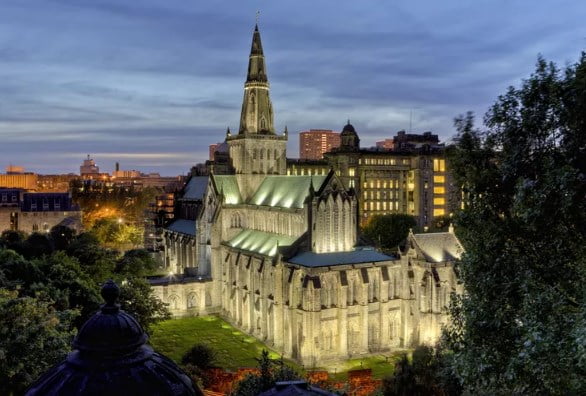Glasgow Cathedral is the oldest Cathedral in Scotland and the only one to survive the Scottish Reformation of the 15th century intact. Officially named as St. Kentigern’s — but usually known as St. Mungos — it is the property of the Crown, rather than of any church and looked after by a government agency, Historic Environment Scotland.
A History of Glasgow Cathedral
The foundation of the Cathedral and the city of Glasgow happened at pretty much the same time. St. Kentigern founded a monastery on the banks of a stream called Molindinar Burn sometime in the 5th century and a community grew up around it. When he died, in 603, he was buried in his church — probably a small wooden church — on the spot where the current Cathedral now stands. The stone Cathedral you can visit today was built in the 11th and 12th centuries and consecrated during the reign of Scotland’s King David in 1136.
The tomb in the crypt or lower church is believed to be that of St. Kentigern.
You may have also noticed that the Cathedral has a lot of names. It is also called a High Kirk of Scotland and is named after saint with two different names.

St. Kentigern or St. Mungo
St. Kentigern was born the child of a Scottish princess of the area that became Lothian and Owain, King of Rheged, an area currently in Northwest England and the Scottish Borders. Some stories say they were lovers, others that she was raped by Owain. Either way, he was still married when she became pregnant. Her father, none to pleased, threw her off a cliff. Luckily she survived only to be set adrift in a coracle that floated across to Fife, where St. Kentigern was born. Kentigern was the name he was baptized with. Later, he was raised by St. Serf who ministered to the Picts. St. Serf gave him the nickname Mungo, which means little dear. The people of Glasgow, which grew up around his church, prefered to call him that — thus the two name confusion.
How the Church Kept its Roof
The Scottish Reformation was part of the Protestant Reformation across Europe but Scotland was not then united with England. It was a separate sovereign kingdom with ties, through its monarch, with France. It remained a Catholic country for almost 30 years after Henry VIII broke from Rome. Henry’s dissolution of the monasteries led to a great deal of destruction of the English Abbeys. But in Scotland, the royal family continued having Catholic leanings. The destruction of the churches and Cathedrals there was a bottom up movement, often carried out by anti-Catholic mobs. The people of Glasgow were, apparently, too fond of their beautiful Gothic Cathedral to destroy it. One theory is that Glasgow at the time had such a large population that the roving, destructive iconoclasts were in the minority there.
While it was stripped of its connections with Rome, it became a parish church. For a while it had three different congregations using parts of it. But it in the mid-19th century, authorities recognized its historic and aesthetic importance and gave it over to one Church of Scotland congregation. Today, while it is commonly referred to as a Cathedral, it is actually a High Kirk of Glasgow.
How to Visit Glasgow Cathedral
The Cathedral is open to the public for visits everyday except December 25-26 and January 1-2. Worshippers are welcome to attend the services on those days as well as normal Sunday worship. Visits are free. Children younger than 16 must be accompanied by an adult. Opening hours vary seasonally and are different for the lower church — where the crypt is located — and the upper church. Check the Historic Scotland website for up-to-date information on opening times. The Cathedral is located in the center of Glasgow, about a 15 minute walk from George’s Square and Queen Street Station, Glasgow’s main rail station. You can also take the 38 or 57 SimpliCITY Buses run by First Greater Glasgow..
Highlights of a Visit
The Cathedral is set into a hill. As a result it’s on two levels with an upper and lower church. Among the highlights:
The crypt of St Kentigern built in the 1200s to house the remains of the founder of both the church and of Glasgow.
An unusual arrangement of three aisles in the nave. Look up at the ceiling of this third, shorter aisle. It is known as Blackadder’s aisle, named for the bishop who had it built. The ceiling is particularly richly carved and studded with colorfully painted bosses.
A carved stone screen between the choir and the nave, called the pulpitum and added in the 14th century.
One of the best collections of post WWII stained glass windows in Britain. Look, especially, for the Millennium Window by John Clark and the 1958 Creation Window by Francis Spear.
Take a guided tour of the Cathedral. Volunteer guides are available to take one to three people on a one hour guided tour of the church. There is no charge for the tour but donations to the church are suggested.
Things to Do Near Glasgow Cathedral
The Cathedral is the oldest building in the city and sits in its most historic area. Nearby visit:
Provand’s Lordship: The second oldest building in Glasgow was built in 1471. It’s one of four surviving medieval houses in the city. It’s furnished as it would have been in the 1600s and sits beside a peaceful herb garden typical of its period.
St. Mungo Museum of Religious Life and Art: Created on the site of a Medieval bishops palace, the museum is designed to look like an ancient building — in keeping with its neighbors, the Cathedral and Provand’s Lordship, but it is actually a modern structure. Its galleries explore the role of religion in the lives and culture of people from all over the world and of all faiths. It may sound rather dry, but this unique museum is full of fascinating artwork — modern and ancient, permanent and visiting exhibitions. If you’ve come to see the Cathedral, you really should cross the street to this unusual place.
The Glasgow Necropolis: The Necropolis occupies a stony hill beside the Cathedral and high above Glasgow, commanding amazing views of the city. It was originally planned as a garden park and arboretum but in the early 19th century it became a cemetery deliberately designed to be similar to the famous Père Lachaise Cemetery in Paris.It’s full of elaborate Victorian mausoleums and stone angels. There’s a full schedule of free walking tours you can book that explain the history, design, plant and wildlife, and famous residents of the Necropolis. The park covers 37 acres and visits or tours take about two hours.

